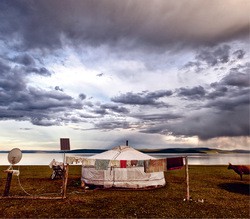Steppe Change
Often unnoticed, Mongolia is one of the world’s fastest-growing economies, with double-digit growth thanks to the discovery of vast mineral resources, especially copper and coking coal. By some estimates this windfall is worth $3 trillion – equivalent to one million dollars for every one of Mongolia’s near three million people.
While this has been a boom to this remote, landlocked nation, there are risks if it is not managed wisely. How can the mining industry and its revenues best be developed and managed while charting a course towards long-term sustainable and diversified growth? What forms of economic diversification should be pursued? What trade and investment relationships will be needed to achieve both?
How can the mining industry and its revenues best be developed and managed while charting a course towards long-term sustainable and diversified growth? What forms of economic diversification should be pursued? What trade and investment relationships will be needed to achieve both? No one can predict the future, but three scenarios envisaged by the World Economic Forum show possible ways to guide Mongolia as it makes strategic decisions that will define the country’s future
No one can predict the future, but three scenarios envisaged by the World Economic Forum show possible ways to guide Mongolia as it makes strategic decisions that will define the country’s future.
The first scenario, called ‘Regional Renaissance,’ paints a picture of increasing economic and political integration in north-east Asia, including North Korea, China and Russia. Right in the middle of this is Mongolia, which benefits from strong demand for its minerals, as well as other opportunities to diversify its economy.
‘Resource Tensions,’ the second scenario, postulates the opposite – a rise in nationalist sentiment and territorial disputes, with access to resources often used as a strategic weapon. In this scenario, Mongolia’s vast mineral wealth risks being stranded in the ground while opportunities to diversify its economy are severely curtailed.
The third scenario, ‘China Greening,’ envisages that by 2040 China has become a world leader in green technologies and the circular economy. In this future path, a shift in environmental attitudes in China results in a concerted push for energy efficiency and the pioneering of new products and services. This scenario sees reduced demand for Mongolia’s main minerals, but opens up new export possibilities for the country, such as niche, high-end organic food products and solar and wind power generation in the expanses of the Gobi Desert.
Regardless of which scenario develops, they all point to a need for common policy responses to strategic decisions, such as developing a good investment and business climate for minerals and other sectors, designing a form of sovereign wealth fund that can operate as an investment fund or development fund as needed, and actively engaging with neighbours in the region to forge strong political and economic relationships.
The last couple of years have already shown the dangers of neglecting these priorities. Calls for renegotiation of the Oyu Tolgoi copper and gold mine (currently owned 66% by Rio Tinto and 34% by the government of Mongolia), and the passing of laws – motivated by fears of foreign enterprises controlling strategic national assets – combined to spook investors and caused FDI to plummet.
Since embarking on this scenarios project in collaboration with the World Economic Forum, the Mongolian government has already started to take a more strategic long-term view, for example replacing the above law with a new one giving more security to investors.
The individual scenarios also suggest interesting choices for Mongolia to consider: for example, facilitating cross-border infrastructure for regional economic co-operation in ‘Regional Renaissance’; joining regional supply chains for green and sustainable industries in ‘China Greening’; and locking in long-term contracts to hedge against regional instability in the ‘Resource Tensions’ scenario.
Mongolia is a major success story which should not be taken for granted. In just over two decades it has transitioned away from Soviet influence to a democratic and open system of governance, which upholds human rights and is making positive strides to curb corruption. With vision and determination, Mongolia’s future can be brighter still.
 Trudi Lang is Associate Director in the World Economic Forum’s Strategic Foresight team.
Trudi Lang is Associate Director in the World Economic Forum’s Strategic Foresight team.












